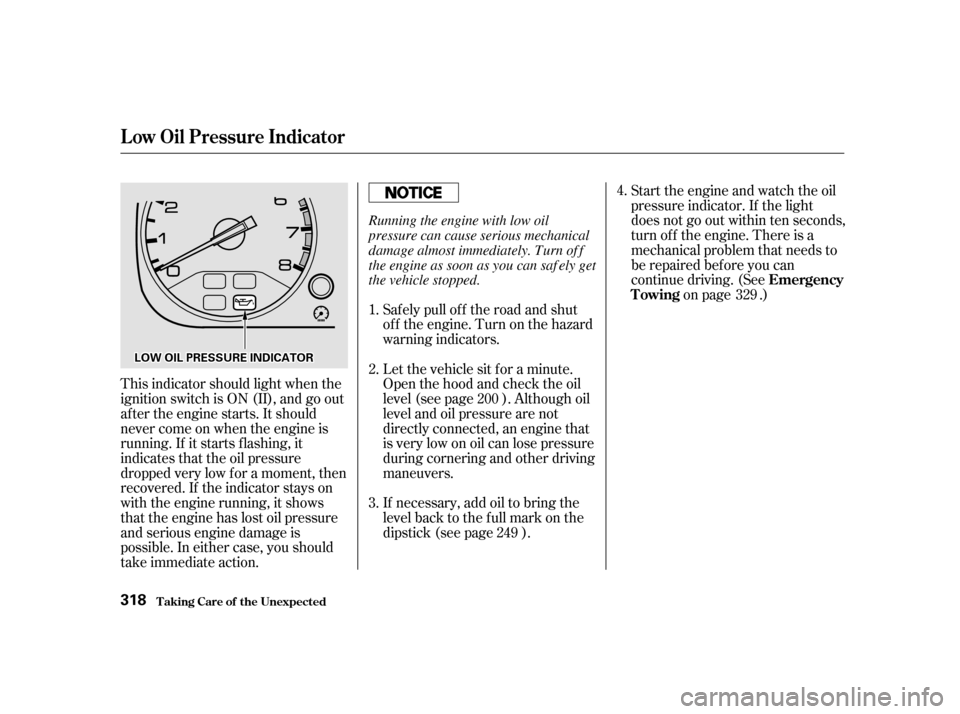2001 HONDA ODYSSEY engine Check warning
[x] Cancel search: engine Check warningPage 63 of 363

The lef t or right turn signal light
blinks when you signal a lane change
or turn. If the light does not blink or
blinks rapidly, it usually means one
of the turn signal bulbs is burned out
(see page ). Replace the bulb as
soon as possible, since other drivers
cannot see that you are signalling.
WhenyouturnontheHazard
Warning switch, both turn signal
lights blink. All turn signals on the
outside of the vehicle should f lash.
This indicator comes on f or a f ew
seconds when you turn the ignition
switch ON (II). If it comes on at any
other time, there is a problem in the
power sliding door system. With this
light on, move the main switch on
the dashboard to the OFF position,
and have the system checked by
your Honda dealer as soon as
possible. You can still open or close
each sliding door manually. For
more inf ormation on the power
sliding doors, see page .
All the lights in the monitor display
come on when you turn the ignition
switch ON (II). The lights go of f
after the engine starts and the
tailgate and all doors are closed
tightly.
A burned out brake light is a hazard
when drivers behind you cannot tell
you are braking. Have your brake
lights repaired right away.
The appropriate light comes on in
this display if the tailgate or any door
is not closed tightly. If a brake light
does not work, the
indicator comes on when you push
the brake pedal with the ignition
switch ON (II).
94 283
EX model only
Door and Brake L amp Monitor
Turn Signal and
Hazard Warning
Indicators
Power Sliding Door
Indicator
Indicator L ights
Inst rument s and Cont rols
64 BRAKE LAMP
Page 312 of 363

To jump start your vehicle, f ollow
these directions closely:
If your vehicle’s battery has run
down, you may be able to start the
engine by using a booster battery.
Although this seems like a simple
procedure, you should take several
precautions.
Put the transmission in Neutral or
Park and set the parking brake.
In this case, the starter motor’s
speed sounds normal, or even f aster
than normal, when you turn the
ignition switch to START (III), but
the engine does not run.
Open the hood and check the
physical condition of the battery
(see page ). In very cold
weather, check the condition of
the electrolyte. If it seems slushy
or like ice, do not try jump starting
until it thaws.
You cannot start a Honda by pushing
or pulling it.
Are you using the proper starting
procedure? Ref er to
on page .
Do you have f uel? Turn the
ignition switch to ON (II) for a
minute and watch the f uel gauge.
The low f uel level warning light
may not be working, so you were
not reminded to f ill the tank.
There may be an electrical
problem, such as no power to the
f uel pump. Check all the f uses
(see page ). Turn of f all the electrical acces-
sories: heater, A/C, climate
control, stereo system, lights, etc.
If youfindnothingwrong,youwill
need a qualif ied technician to f ind
the problem. See on page . 1. 2.
211
323 329 267
CONT INUED
T he Starter Operates Normally Jump Starting
Starting the
Engine
Emergency
Towing
If Your Engine Won’t Start, Jump Starting
T aking Care of t he Unexpect ed 313
A battery can explode if you do
not follow the correct procedure,
seriously injuring anyonenearby.
Keep all sparks, open flames,
and smoking materials away
from the battery.
If a battery sits in extreme cold, the
electrolyte inside can f reeze.
Attempting to jump start with a f rozen
battery can cause it to rupture.
Page 315 of 363

Saf ely pull to the side of the road.
Put the transmission in Neutral or
Park and set the parking brake.
Turn of f the heating and cooling/
climate control system and all
otheraccessories.Turnonthe
hazard warning indicators.
If you see steam and/or spray
coming f rom under the hood, turn
of f the engine.If you do not see steam or spray,
leave the engine running and
watch the temperature gauge. If
the high heat is due to overloading
(climbing a long, steep hill on a
hot day with the A/C running, f or
example), the engine should start
to cool down almost immediately.
If it does, wait until the tempera-
ture gauge comes down to the mid-
point then continue driving.
If the temperature gauge stays at
the red mark, turn of f the engine.
Wait until you see no more signs
of steam or spray, then open thehood.Look f or any obvious coolant leaks,
such as a split radiator hose.
Everything is still extremely hot,
so use caution. If you f ind a leak, it
must be repaired bef ore you
continue driving (see
on page ).
If you don’t f ind an obvious leak,
check the coolant level in the
radiator reserve tank (see page ). If the level is below the
MIN mark, add coolant to halfway
between the MIN and MAX marks.
1. 2.
3.
7.
6.
5.
4. 329
201
If Your Engine Overheats
T aking Care of t he Unexpect ed Emergency
Towing
316
Page 317 of 363

This indicator should light when the
ignition switch is ON (II), and go out
af ter the engine starts. It should
never come on when the engine is
running. If it starts f lashing, it
indicates that the oil pressure
dropped very low f or a moment, then
recovered. If the indicator stays on
with the engine running, it shows
that the engine has lost oil pressure
and serious engine damage is
possible. In either case, you should
take immediate action.Saf ely pull of f the road and shut
of f the engine. Turn on the hazard
warning indicators.
If necessary, add oil to bring the
level back to the full mark on the
dipstick (see page ).
Let the vehicle sit f or a minute.
Open the hood and check the oil
level (see page ). Although oil
levelandoilpressurearenot
directly connected, an engine that
is very low on oil can lose pressure
during cornering and other driving
maneuvers. Start the engine and watch the oil
pressure indicator. If the light
does not go out within ten seconds,
turn of f the engine. There is a
mechanical problem that needs to
be repaired bef ore you can
continue driving. (See
on page .)
1. 2. 3. 4.
200 249 329
Emergency
Towing
L ow Oil Pressure Indicator
T aking Care of t he Unexpect ed
318
LLOOWWOOIILLPPRREESSSSUURREEIINNDDIICCAATTOORR Running the engine with low oil
pressure can cause serious mechanical
damage almost immediately. Turn of f
the engine as soon as you can saf ely get
the vehicle stopped.
Page 354 of 363

CONT INUED
Dipstick..........
Automatic Transmission . 259
..................................
Engine Oil . 200
..........................
Directional Signals . 72
........
Disc Brake Wear Indicators . 218
.....................
Disposal of Used Oil . 252
Doors
..............
Locking and Unlocking . 83
....................
Lockout Prevention . 84
.................
Manual Sliding Doors . 92
..............................
Monitor Light . 64
......................
Power Door Locks . 83
...................
Power Sliding Doors . 94
..........
DOT Tire Quality Grading . 336
.....................................
Drive Belts . 272
...........
Driver and Passenger Safety . 5
...........................................
Driving . 209
....................................
Economy . 202
.........................
In Bad Weather . 224
................
In Foreign Countries . 339 ............................
Fabric, Cleaning . 297
..........................
Fan, Interior . 136, 148
Features, Comfort and
..............................
Convenience . 135
....................
Filling the Fuel Tank . 197
Filters
...............................................
Air . 262
.......................
Air Conditioning . 272
...............................................
Oil . 251
.............
Flashers, Hazard Warning . 75
...................
Flat Tire, Changing a . 303
.......................................
Floor Mat . 296
Fluids
..........
Automatic Transmission . 259
..........................................
Brake . 260
..........................
Power Steering . 261
..............................
Economy, Fuel . 202
............
Emergencies on the Road . 301
.............
Battery, Jump Starting . 313 Emergencies on the Road
...........
Brake System Indicator . 322
................
Changing a Flat Tire . 303
.....
Charging System Indicator . 319
..................
Checking the Fuses . 323
.....
Low Oil Pressure Indicator . 318
...
Malf unction Indicator Lamp . 320
..................
Overheated Engine . 315
.........................
Emergency Brake . 122
......................
Emergency Flashers . 75
......................
Emergency Towing . 329
.......................
Emissions Controls . 340
.............
Emissions Testing, State . 343Engine
....
Coolant Temperature Gauge . 67
.................................
Drive Belts . 272
Malf unction Indicator
................................
Lamp . 62, 320
........
Oil Pressure Indicator . 62, 318
..............
Oil, What Kind to Use . 249
...............................
Overheating . 315
............................
Specif ications . 335
.......................................
Starting . 211
......................
Ethanol in Gasoline . 338
.
Evaporative Emissions Controls . 340
...............................
Exhaust Fumes . 57 Exhaust Gas Recirculation
........................................
System . 341
Expectant Mothers, Use of Seat ........................................
Belts by . 20
..................
Exterior,Cleaningthe .294
Index
E F
III
Page 355 of 363

Fluids..................
Windshield Washer . 258
FM Stereo Radio
...........................
Reception . 162, 174
.................
Folding the Third Seat . 115
.....
Foreign Countries, Driving in . 339
..........................
Four-way Flashers . 75
.................................................
Fuel . 196
......................
Fill Door and Cap . 197
...........................................
Gauge . 67
................
Octane Requirement . 196
...............................
Oxygenated . 338
........................
Reserve Indicator . 65
........................
Tank, Filling the . 197
.....................
Fuses, Checking the . 324
...............
Gas Mileage, Improving . 202
..........................................
Gasohol . 338
.........................................
Gasoline . 196
...............
Fuel Reserve Indicator . 65
...........................................
Gauge . 67
................
Octane Requirement . 196
........................
Tank, Filling the . 197
................
Gas Station Procedures . 197 Gauges
...
Engine Coolant Temperature . 67
...............................................
Fuel . 67
...............................
Speedometer . 66
.................................
Tachometer . 66
GAWR (Gross Axle Weight
.......................................
Rating) . 228
GCWR (Gross Combined Weight .......................................
Rating) . 228
............
Gearshif t Lever Positions . 213
..............................
Glass Cleaning . 298
........................................
Glove Box . 91
GVWR (Gross Vehicle Weight
.......................................
Rating) . 228
.............
Halogen Headlight Bulbs . 282
..............
Hazard Warning Flashers . 75
........................................
Headlights . 70
........................................
Aiming . 282
..............
Automatic Lighting Off . 71
............
Daytime Running Lights . 71
..................
High Beam Indicator . 65
.........................
Reminder Chime . 70
........
Replacing Halogen Bulbs . 282 ...................................
Turning on . 70
............................
Head Restraints . 110
...............................
Heated Mirror . 122
.....................
Heating and Cooling . 136
.............
High Altitude, Starting at . 211
.................
High-Low Beam Switch . 70
HomeLink Universal
.................................
Transmitter . 99
....................................
Hood Latch . 264
.......................
Hood, Opening the . 198
..................................................
Horn . 69
.................................
Hydroplaning . 225
...
Identif ication Number, Vehicle . 332
Ignition
..............................................
Keys . 80
...........................................
Switch . 82
............
Timing Control System . 341
........................
Immobilizer System . 81
.........
Important Safety Precautions . 6
.........
Indicators, Instrument Panel . 61
..................
Individual Map Lights . 133
...............................
Inf ant Restraint . 32
Index
G H I
IV